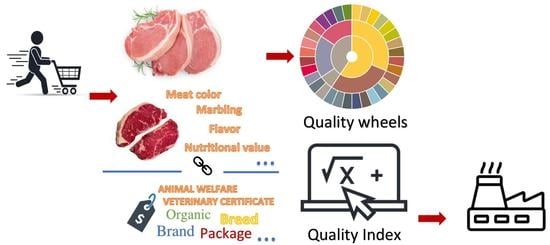Quality Multiverse of Beef and Pork Meat in a Single Score
Abstract
:1. Introduction
2. Research Methodology
3. Quality Cues
3.1. Intrinsic Quality Cues
3.1.1. Meat Color
3.1.2. Sensory Characteristics
3.1.3. Fat Content
3.1.4. Marbling
3.1.5. Cut
3.1.6. Amount of Drip
- The time postmortem and the duration of measurement;
- Geometry of the piece;
- Temperature during the measurement;
- Type of package;
- The sample’s position within the package.
3.1.7. Texture
3.2. Extrinsic Quality Cues
3.2.1. Brand
3.2.2. Label
3.2.3. Package
3.2.4. Animal Breed
3.2.5. Animal Welfare
3.2.6. Price
3.2.7. Other Extrinsic Quality Cues
4. Quality Wheels
5. Quality Index in Meat Industry
- The nearer to the target value the parameter is, the better the quality is;
- The smaller the characteristic’s value is, the better the quality is;
- The higher the characteristic’s value is, the better the quality is.
6. Conclusions and Future Trends
Author Contributions
Funding
Institutional Review Board Statement
Informed Consent Statement
Data Availability Statement
Conflicts of Interest
References
- Bredahl, L. Cue utilisation and quality perception with regard to branded beef. Food Qual. Prefer. 2004, 15, 65–75. [Google Scholar] [CrossRef]
- Henchion, M.; McCarthy, M.; Resconi, V.C.; Troy, D. Meat consumption: Trends and quality matters. Meat Sci. 2014, 98, 561–568. [Google Scholar] [CrossRef] [PubMed] [Green Version]
- Acebrón, L.B.; Dopico, D.C. The importance of intrinsic and extrinsic cues to expected and experienced quality: An empirical application for beef. Food Qual. Prefer. 2000, 11, 229–238. [Google Scholar] [CrossRef]
- Banović, M.; Grunert, K.G.; Barreira, M.M.; Fontes, M.A. Beef quality perception at the point of purchase: A study from Portugal. Food Qual. Prefer. 2009, 20, 335–342. [Google Scholar] [CrossRef]
- Bernués, A.; Olaizola, A.; Corcoran, K. Labelling information demanded by European consumers and relationships with purchasing motives, quality and safety of meat. Meat Sci. 2003, 65, 1095–1106. [Google Scholar] [CrossRef]
- Lagerkvist, C.J. Consumer preferences for food labelling attributes: Comparing direct ranking and best–worst scaling for measurement of attribute importance, preference intensity and attribute dominance. Food Qual. Prefer. 2013, 29, 77–88. [Google Scholar] [CrossRef]
- Noble, A.C.; Arnold, R.A.; Buechsenstein, J.; Leach, E.J.; Schmidt, J.O.; Stern, P.M. Modification of a Standardized System of Wine Aroma Terminology. Am. J. Enol. Vitic. 1987, 38, 143. [Google Scholar]
- Schouteten, J.J.; De Steur, H.; De Pelsmaeker, S.; Lagast, S.; De Bourdeaudhuij, I.; Gellynck, X. An integrated method for the emotional conceptualization and sensory characterization of food products: The EmoSensory® Wheel. Food Res. Int. 2015, 78, 96–107. [Google Scholar] [CrossRef]
- Molnár, P.J. A model for overall description of food quality. Food Qual. Prefer. 1995, 6, 185–190. [Google Scholar] [CrossRef]
- Finotti, E.; Bersani, A.M.; Bersani, E. Total quality indexes for extra-virgin olive oils. J. Food Qual. 2007, 30, 911–931. [Google Scholar] [CrossRef]
- Curic, D.; Novotni, D.; Skevin, D.; Rosell, C.M.; Collar, C.; Le Bail, A.; Colic-Baric, I.; Gabric, D. Design of a quality index for the objective evaluation of bread quality: Application to wheat breads using selected bake off technology for bread making. Food Res. Int. 2008, 41, 714–719. [Google Scholar] [CrossRef]
- Araujo, Q.R.; Fernandes, C.A.F.; Ribeiro, D.O.; Efraim, P.; Steinmacher, D.; Lieberei, R.; Bastide, P.; Araujo, T.G. Cocoa Quality Index—A proposal. Food Control 2014, 46, 49–54. [Google Scholar] [CrossRef]
- Djekic, I.; Vunduk, J.; Tomašević, I.; Kozarski, M.; Petrovic, P.; Niksic, M.; Pudja, P.; Klaus, A. Total quality index of Agaricus bisporus mushrooms packed in modified atmosphere. J. Sci. Food Agric. 2017, 97, 3013–3021. [Google Scholar] [CrossRef] [PubMed]
- Doroški, A.; Klaus, A.; Kozarski, M.; Cvetković, S.; Nikolić, B.; Jakovljević, D.; Tomasevic, I.; Vunduk, J.; Lazić, V.; Djekic, I. The influence of grape pomace substrate on quality characterization of Pleurotus ostreatus—Total quality index approach. J. Food Processing Preserv. 2021, 45, e15096. [Google Scholar] [CrossRef]
- Režek Jambrak, A.; Šimunek, M.; Djekic, I. Total quality index of ultrasound-treated blueberry and cranberry juices and nectars. Food Sci. Technol. Int. 2018, 24, 434–446. [Google Scholar] [CrossRef] [PubMed]
- Djekic, I.; Tomic, N.; Bourdoux, S.; Spilimbergo, S.; Smigic, N.; Udovicki, B.; Hofland, G.; Devlieghere, F.; Rajkovic, A. Comparison of Three Types of Drying (supercritical CO2, Air and Freeze) on the Quality of Dried Apple: Quality Index Approach. LWT Food Sci. Technol. 2018, 94, 64–72. [Google Scholar] [CrossRef]
- King, I. Handbook of Australian Meat, 7th ed.; International Red Meat Manual; AUS-MEAT: Murarrie, QLD, Australia, 2005; ISBN 0-9578793-69. [Google Scholar]
- Barragán-Hernández, W.; Mahecha-Ledesma, L.; Angulo-Arizala, J.; Olivera-Angel, M. Near-Infrared Spectroscopy as a Beef Quality Tool to Predict Consumer Acceptance. Foods 2020, 9, 984. [Google Scholar] [CrossRef]
- Li, X.; Zhang, D.; Ijaz, M.; Tian, G.; Chen, J.; Du, M. Colour characteristics of beef longissimus thoracis during early 72 h postmortem. Meat Sci. 2020, 170, 108245. [Google Scholar] [CrossRef]
- López-Pedrouso, M.; Rodríguez-Vázquez, R.; Purriños, L.; Oliván, M.; García-Torres, S.; Sentandreu, M.Á.; Lorenzo, J.M.; Zapata, C.; Franco, D. Sensory and Physicochemical Analysis of Meat from Bovine Breeds in Different Livestock Production Systems, Pre-Slaughter Handling Conditions, and Ageing Time. Foods 2020, 9, 176. [Google Scholar] [CrossRef] [Green Version]
- Tomasevic, I.; Tomovic, V.; Milovanovic, B.; Lorenzo, J.; Đorđević, V.; Karabasil, N.; Djekic, I. Comparison of a computer vision system vs. traditional colorimeter for color evaluation of meat products with various physical properties. Meat Sci. 2019, 148, 5–12. [Google Scholar] [CrossRef]
- Testa, M.L.; Grigioni, G.; Panea, B.; Pavan, E. Color and Marbling as Predictors of Meat Quality Perception of Argentinian Consumers. Foods 2021, 10, 1465. [Google Scholar] [CrossRef] [PubMed]
- Dashdorj, D.; Amna, T.; Hwang, I. Influence of specific taste-active components on meat flavor as affected by intrinsic and extrinsic factors: An overview. Eur. Food Res. Technol. 2015, 241, 157–171. [Google Scholar] [CrossRef]
- Boito, B.; Lisbinski, E.; Campo, M.D.M.; Guerrero, A.; Resconi, V.; de Oliveira, T.E.; Barcellos, J.O.J. Perception of beef quality for Spanish and Brazilian consumers. Meat Sci. 2021, 172, 108312. [Google Scholar] [CrossRef] [PubMed]
- Ivanovic, S.; Pavlović, M.; Pavlović, I.; Savić, B.; Nešić, K.; Mitrović, R.; Baltić, B. Meat quality parameters of wild boar and commercial pig breeds. Meat Technol. 2021, 62, 1–13. [Google Scholar] [CrossRef]
- Tomasevic, I.; Djekic, I.; Font-i-Furnols, M.; Terjung, N.; Lorenzo, J.M. Recent advances in meat color research. Curr. Opin. Food Sci. 2021, 41, 81–87. [Google Scholar] [CrossRef]
- Altmann, B.A.; Gertheiss, J.; Tomasevic, I.; Engelkes, C.; Glaesener, T.; Meyer, J.; Schäfer, A.; Wiesen, R.; Mörlein, D. Human perception of color differences using computer vision system measurements of raw pork loin. Meat Sci. 2022, 188, 108766. [Google Scholar] [CrossRef]
- Holman, B.W.B.; Collins, D.; Kilgannon, A.K.; Hopkins, D.L. Using shear force, sarcomere length, particle size, collagen content, and protein solubility metrics to predict consumer acceptance of aged beef tenderness. J. Texture Stud. 2020, 51, 559–566. [Google Scholar] [CrossRef]
- Henchion, M.M.; McCarthy, M.; Resconi, V.C. Beef quality attributes: A systematic review of consumer perspectives. Meat Sci. 2017, 128, 1–7. [Google Scholar] [CrossRef] [Green Version]
- Mwashiuya, J.T.; Manyele, S.V.; Mwaluko, G. Assessment of Beef Quality Determinants Based on Consumer Preferences. J. Serv. Sci. Manag. 2018, 11, 657–690. [Google Scholar] [CrossRef] [Green Version]
- Grebitus, C.; Bruhn, M. Analyzing semantic networks of pork quality by means of concept mapping. Food Qual. Prefer. 2008, 19, 86–96. [Google Scholar] [CrossRef]
- Fernández, J.; Melo, O.; Larraín, R.; Fernández, M. Valuation of observable attributes in differentiated beef products in Chile using the hedonic price method. Meat Sci. 2019, 158, 107881. [Google Scholar] [CrossRef] [PubMed]
- Simunovic, S.; Rajic, S.; Djordjevic, V.; Tomovic, V.; Vujadinovic, D.; Djekic, I.; Tomasevic, I. Estimation of fat cover of bovine carcases by means of computer vision system (CVS). IOP Conf. Ser. Earth Environ. Sci. 2021, 854, 12087. [Google Scholar] [CrossRef]
- Simunović, S.; Rajić, S.; Đorđević, V.; Tomović, V.; Vujadinović, D.; Đekić, I.; Tomašević, I. Estimation of fat content in fermented sausages by means of Computer Vision System (CVS). Meat Technol. 2021, 62, 27–32. [Google Scholar] [CrossRef]
- McBee, J.L., Jr.; Wiles, J.A. Influence of Marbling and Carcass Grade on the Physical and Chemical Characteristics of Beef. J. Anim. Sci. 1967, 26, 701–704. [Google Scholar] [CrossRef] [Green Version]
- Ardeshiri, A.; Sampson, S.; Swait, J. Seasonality effects on consumers’ preferences over quality attributes of different beef products. Meat Sci. 2019, 157, 107868. [Google Scholar] [CrossRef] [Green Version]
- Gajaweera, C.; Yong Chung, K.; Gi Kwon, E.; Ho Hwang, I.; Hyun Cho, S.; Hwan Lee, S.; Plaizier, J. Evaluation of sensory attributes of Hanwoo Longissimus dorsi muscle and its relationships with intramuscular fat, shear force, and environmental factors. Can. J. Anim. Sci. 2018, 98, 443–452. [Google Scholar] [CrossRef] [Green Version]
- USDA. Institutional Meat Purchase Specifications; USDA Agricultural Marketing Service: Washington, DC, USA, 2014. [Google Scholar]
- D’Souza, D.N.; Cleary, D.; Hewitt, R.J.E. Consumers want pork with ‘adjectives’. Anim. Prod. Sci. 2017, 57, 2331–2338. [Google Scholar] [CrossRef]
- Fischer, K. Drip loss in pork: Influencing factors and relation to further meat quality traits. J. Anim. Breed. Genet. 2007, 124, 12–18. [Google Scholar] [CrossRef]
- Argemí-Armengol, I.; Villalba, D.; Ripoll, G.; Teixeira, A.; Álvarez-Rodríguez, J. Credence cues of pork are more important than consumers’ culinary skills to boost their purchasing intention. Meat Sci. 2019, 154, 11–21. [Google Scholar] [CrossRef] [Green Version]
- Djekic, I.; Ilic, J.; Lorenzo, J.M.; Tomasevic, I. How do culinary methods affect quality and oral processing characteristics of pork ham? J. Texture Stud. 2021, 52, 36–44. [Google Scholar] [CrossRef]
- Ngapo, T.M.; Riendeau, L.; Laberge, C.; Fortin, J. Marbling and ageing—Part 2. Consumer perception of sensory quality. Food Res. Int. 2013, 51, 985–991. [Google Scholar] [CrossRef]
- Martinez, S.; Hanagriff, R.; Lau, M.; Harris, M. Determining the Factors Affecting Demand for Branded Beef: Applying A Logit Model To 2004 Neilson Home-Scan Data. J. Bus. Econ. Res. 2007, 5, 95–102. [Google Scholar] [CrossRef]
- Arenas de Moreno, L.; Jerez-Timaure, N.; Valerio Hernández, J.; Huerta-Leidenz, N.; Rodas-González, A. Attitudinal Determinants of Beef Consumption in Venezuela: A Retrospective Survey. Foods 2020, 9, 202. [Google Scholar] [CrossRef] [Green Version]
- Mahbubi, A.; Uchiyama, T.; Hatanaka, K. Capturing consumer value and clustering customer preferences in the Indonesian halal beef market. Meat Sci. 2019, 156, 23–32. [Google Scholar] [CrossRef] [PubMed]
- Magalhaes, D.R.; Campo, M.d.M.; Maza, M.T. Knowledge, Utility, and Preferences for Beef Label Traceability Information: A Cross-Cultural Market Analysis Comparing Spain and Brazil. Foods 2021, 10, 232. [Google Scholar] [CrossRef] [PubMed]
- Alves Mauricio, R.; Alvares Duarte Bonini Campos, J.; Tieko Nassu, R. Meat with edible coating: Acceptance, purchase intention and neophobia. Food Res. Int. 2022, 154, 111002. [Google Scholar] [CrossRef] [PubMed]
- Seideman, S.C.; Cross, H.R.; Smith, G.C.; Durland, P.R. Factors associated with fresh meat color: A review. J. Food Qual. 1984, 6, 211–237. [Google Scholar] [CrossRef]
- De Canio, F.; Martinelli, E. EU quality label vs organic food products: A multigroup structural equation modeling to assess consumers’ intention to buy in light of sustainable motives. Food Res. Int. 2021, 139, 109846. [Google Scholar] [CrossRef]
- Ardeshiri, A.; Rose, J.M. How Australian consumers value intrinsic and extrinsic attributes of beef products. Food Qual. Prefer. 2018, 65, 146–163. [Google Scholar] [CrossRef]
- Li, S.; Xiang, C.; Ge, Y.; Liu, H.; Zhang, D.; Wang, Z. Differences in eating quality and electronic sense of meat samples as a function of goat breed and postmortem rigor state. Food Res. Int. 2022, 152, 110923. [Google Scholar] [CrossRef]
- Gross, S.; Waldrop, M.E.; Roosen, J. How does animal welfare taste? Combining sensory and choice experiments to evaluate willingness to pay for animal welfare pork. Food Qual. Prefer. 2021, 87, 104055. [Google Scholar] [CrossRef]
- Blanc, S.; Massaglia, S.; Borra, D.; Mosso, A.; Merlino, V.M. Animal welfare and gender: A nexus in awareness and preference when choosing fresh beef meat? Ital. J. Anim. Sci. 2020, 19, 410–420. [Google Scholar] [CrossRef]
- Burnier, P.C.; Spers, E.E.; de Barcellos, M.D. Role of sustainability attributes and occasion matters in determining consumers’ beef choice. Food Qual. Prefer. 2021, 88, 104075. [Google Scholar] [CrossRef]
- Castillo, M.J.; Carpio, C.E. Demand for High-Quality Beef Attributes in Developing Countries: The Case of Ecuador. J. Agric. Appl. Econ. 2019, 51, 568–590. [Google Scholar] [CrossRef] [Green Version]
- Li, X.; Jensen, K.L.; Lambert, D.M.; Clark, C.D. Consequentiality Beliefs and Consumer Valuation of Extrinsic Attributes in Beef. J. Agric. Appl. Econ. 2018, 50, 1–26. [Google Scholar] [CrossRef] [Green Version]
- Schulze, M.; Spiller, A.; Risius, A. Do consumers prefer pasture-raised dual-purpose cattle when considering meat products? A hypothetical discrete choice experiment for the case of minced beef. Meat Sci. 2021, 177, 108494. [Google Scholar] [CrossRef]
- Stampa, E.; Schipmann-Schwarze, C.; Hamm, U. Consumer perceptions, preferences, and behavior regarding pasture-raised livestock products: A review. Food Qual. Prefer. 2020, 82, 103872. [Google Scholar] [CrossRef]
- Aboah, J.; Lees, N. Consumers use of quality cues for meat purchase: Research trends and future pathways. Meat Sci. 2020, 166, 108142. [Google Scholar] [CrossRef]
- Bottema, M.J.; Kruk, Z.A.; Gontar, A.; Pitchford, W.S.; Bottema, C.D.K. Evidence of marbling as a single connected entity in beef striploins. Meat Sci. 2020, 161, 108004. [Google Scholar] [CrossRef]
- Stewart, S.M.; Gardner, G.E.; McGilchrist, P.; Pethick, D.W.; Polkinghorne, R.; Thompson, J.M.; Tarr, G. Prediction of consumer palatability in beef using visual marbling scores and chemical intramuscular fat percentage. Meat Sci. 2021, 181, 108322. [Google Scholar] [CrossRef]
- Song, X.-C.; Canellas, E.; Wrona, M.; Becerril, R.; Nerin, C. Comparison of two antioxidant packaging based on rosemary oleoresin and green tea extract coated on polyethylene terephthalate for extending the shelf life of minced pork meat. Food Packag. Shelf Life 2020, 26, 100588. [Google Scholar] [CrossRef]
- Ha, M.; McGilchrist, P.; Polkinghorne, R.; Huynh, L.; Galletly, J.; Kobayashi, K.; Nishimura, T.; Bonney, S.; Kelman, K.R.; Warner, R.D. Effects of different ageing methods on colour, yield, oxidation and sensory qualities of Australian beef loins consumed in Australia and Japan. Food Res. Int. 2019, 125, 108528. [Google Scholar] [CrossRef] [PubMed]
- Mohammed, H.H.H.; He, L.; Nawaz, A.; Jin, G.; Huang, X.; Ma, M.; Abdegadir, W.S.; Elgasim, E.A.; Khalifa, I. Effect of frozen and refrozen storage of beef and chicken meats on inoculated microorganisms and meat quality. Meat Sci. 2021, 175, 108453. [Google Scholar] [CrossRef] [PubMed]
- Ijaz, M.; Li, X.; Zhang, D.; Hussain, Z.; Ren, C.; Bai, Y.; Zheng, X. Association between meat color of DFD beef and other quality attributes. Meat Sci. 2020, 161, 107954. [Google Scholar] [CrossRef]
- Fowler, S.M.; Schmidt, H.; van de Ven, R.; Hopkins, D.L. Preliminary investigation of the use of Raman spectroscopy to predict meat and eating quality traits of beef loins. Meat Sci. 2018, 138, 53–58. [Google Scholar] [CrossRef]
- Huang, C.; Zheng, M.; Huang, Y.; Liu, X.; Zhong, L.; Ji, J.; Zhou, L.; Zeng, Q.; Ma, J.; Huang, L. The effect of purine content on sensory quality of pork. Meat Sci. 2021, 172, 108346. [Google Scholar] [CrossRef]
- Athayde, D.R.; Flores, D.R.M.; da Silva, J.S.; Genro, A.L.G.; Silva, M.S.; Klein, B.; Mello, R.; Campagnol, P.C.B.; Wagner, R.; de Menezes, C.R.; et al. Application of electrolyzed water for improving pork meat quality. Food Res. Int. 2017, 100, 757–763. [Google Scholar] [CrossRef]
- Li, X.; Babol, J.; Wallby, A.; Lundström, K. Meat quality, microbiological status and consumer preference of beef gluteus medius aged in a dry ageing bag or vacuum. Meat Sci. 2013, 95, 229–234. [Google Scholar] [CrossRef]
- Terjung, N.; Witte, F.; Heinz, V. The dry aged beef paradox: Why dry aging is sometimes not better than wet aging. Meat Sci. 2021, 172, 108355. [Google Scholar] [CrossRef]
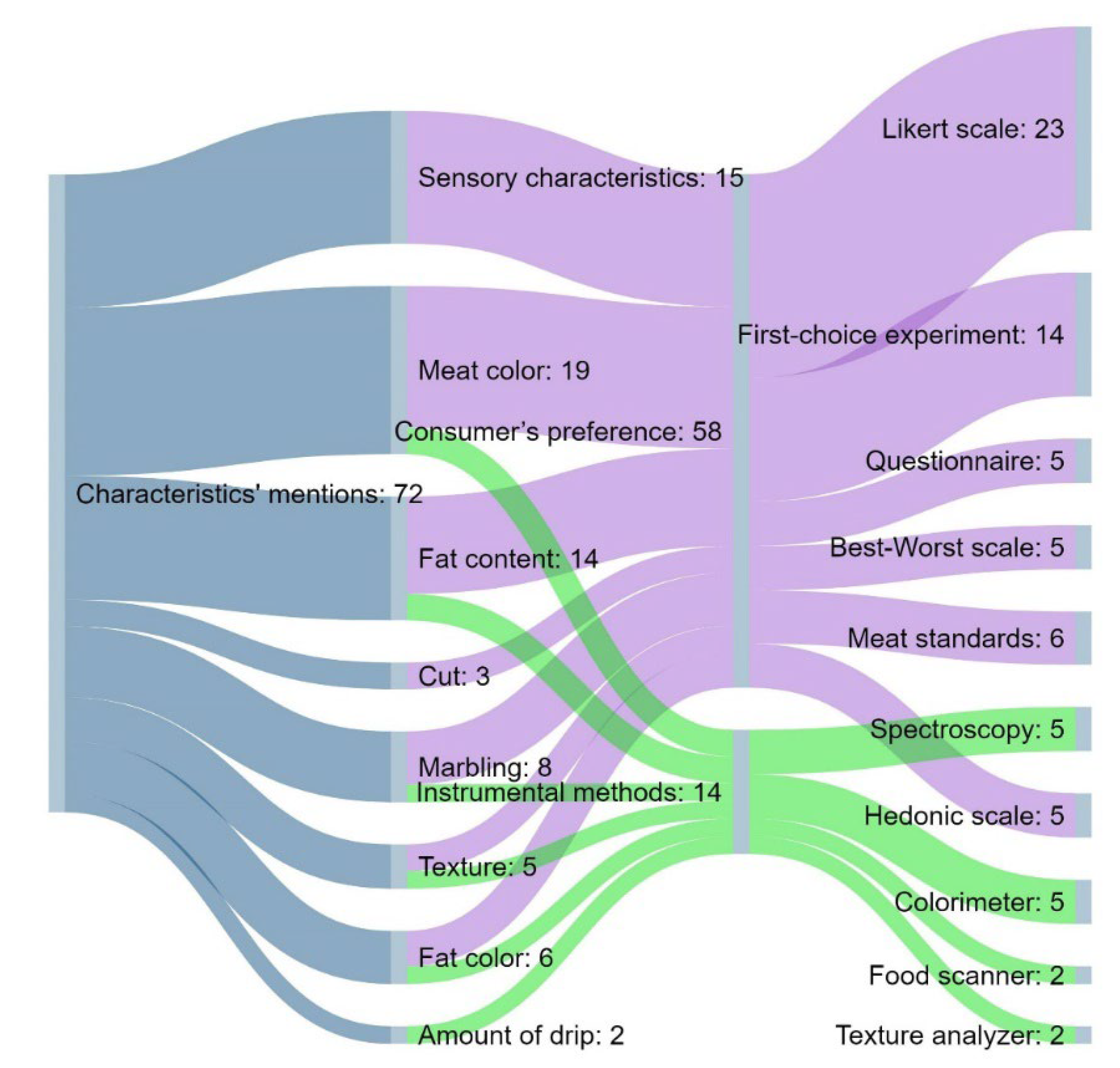
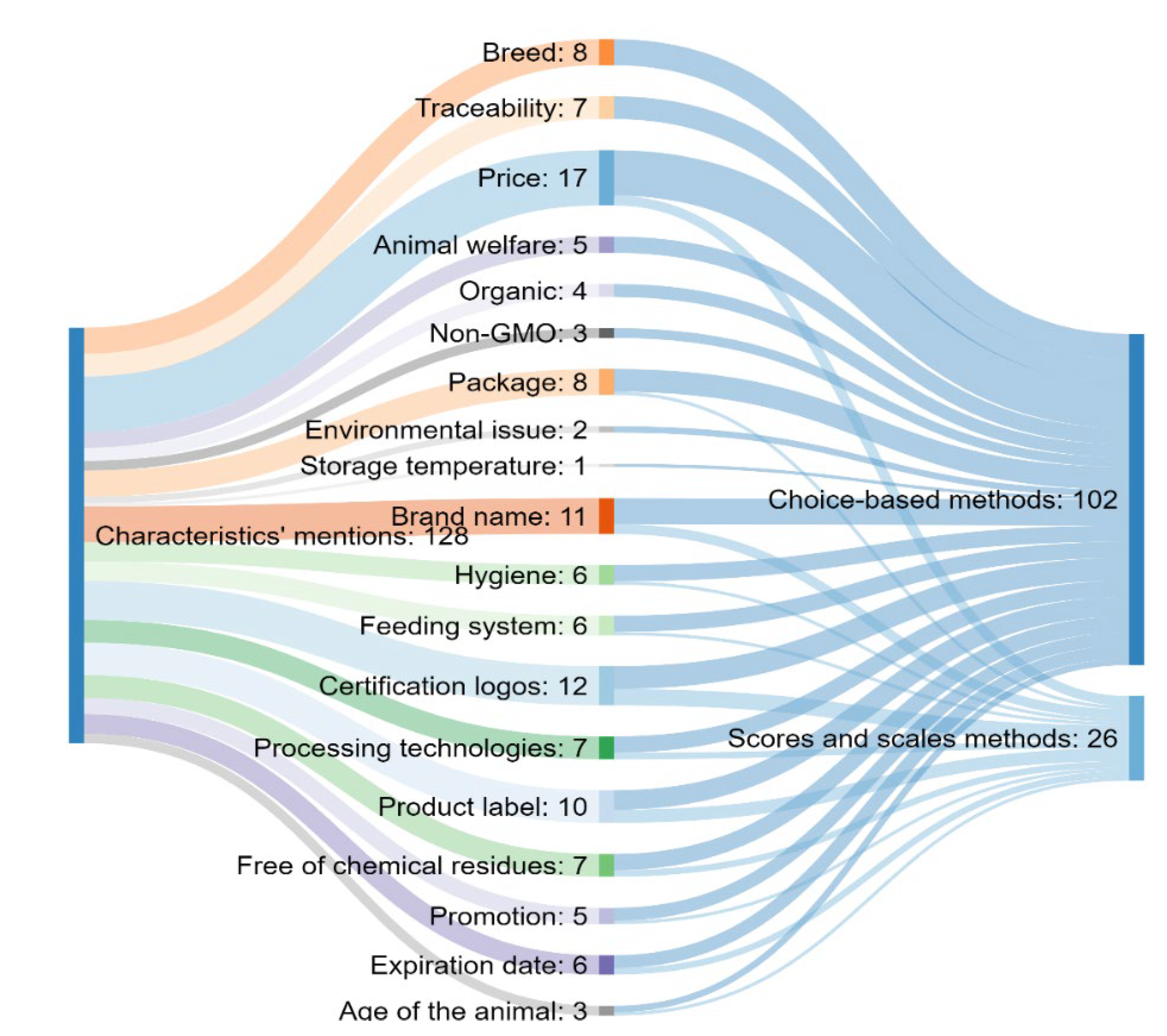
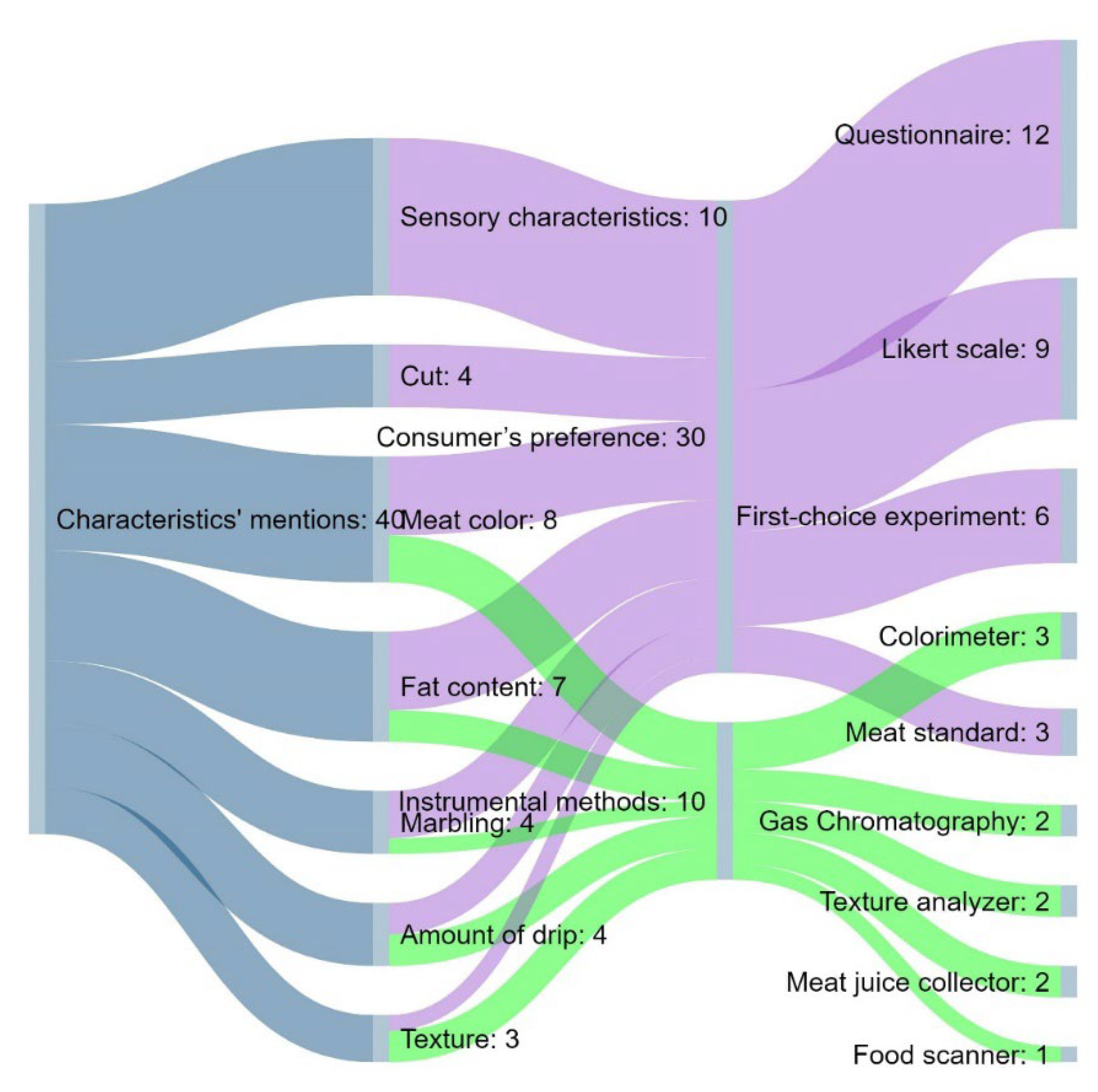
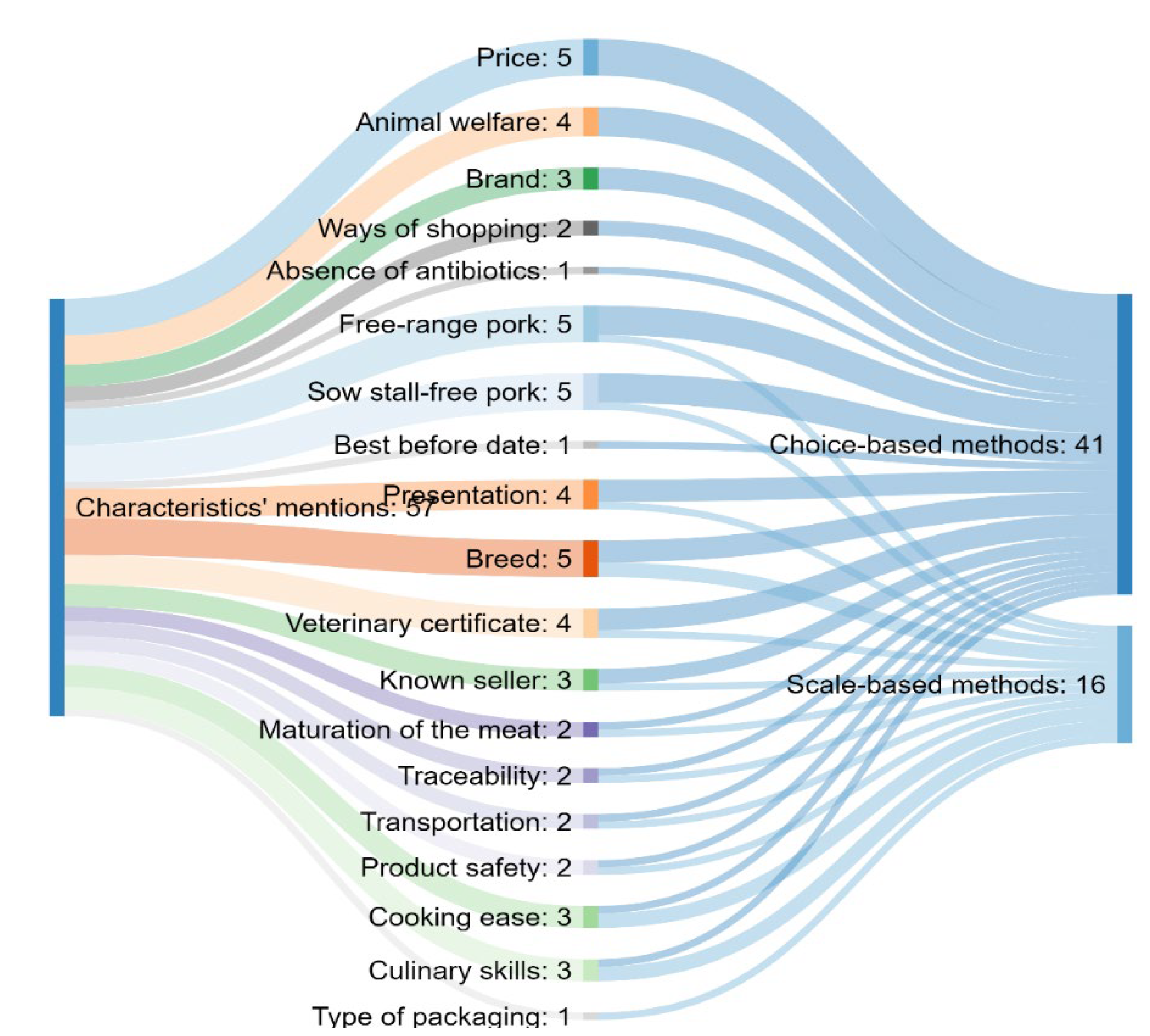
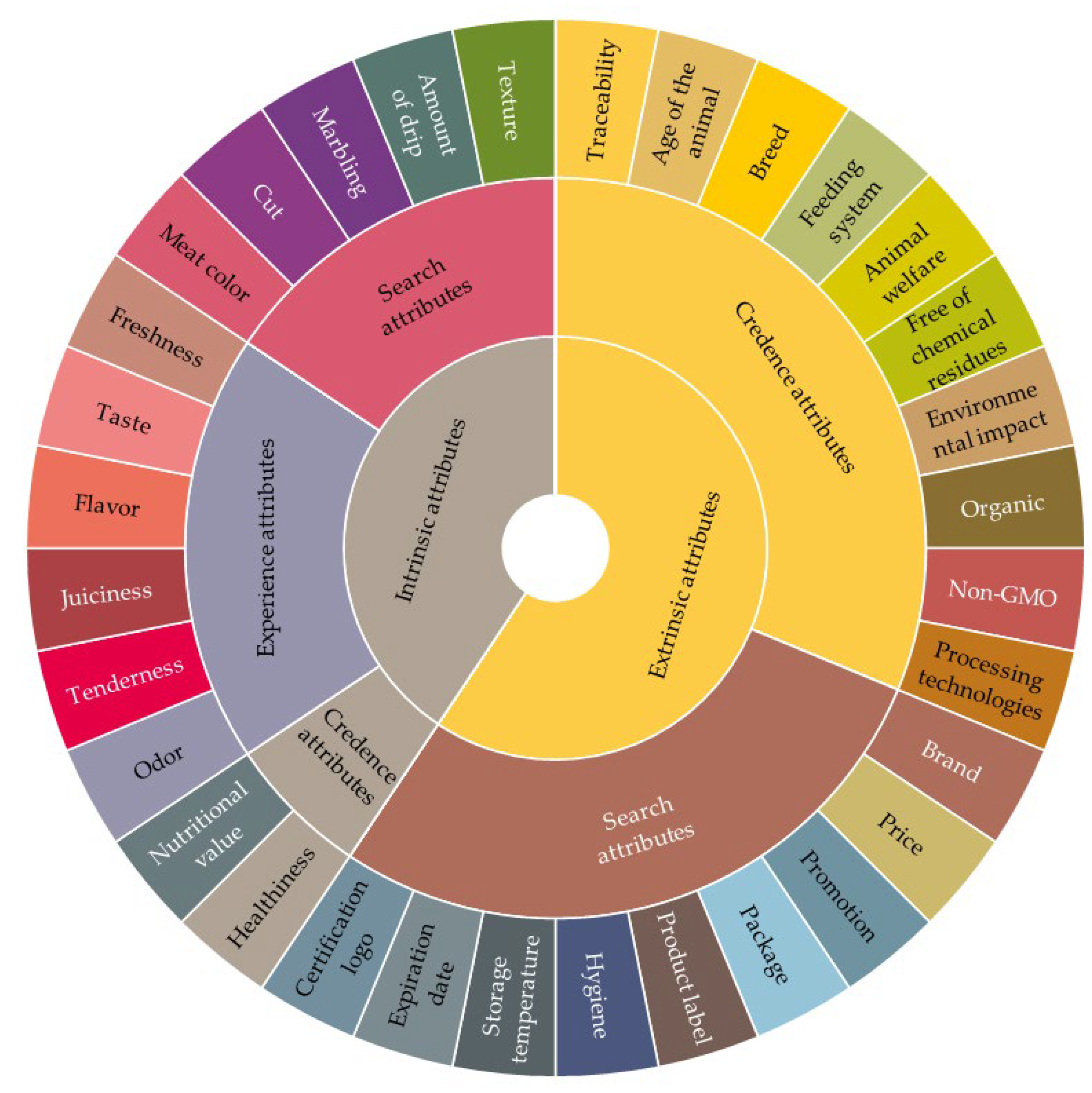
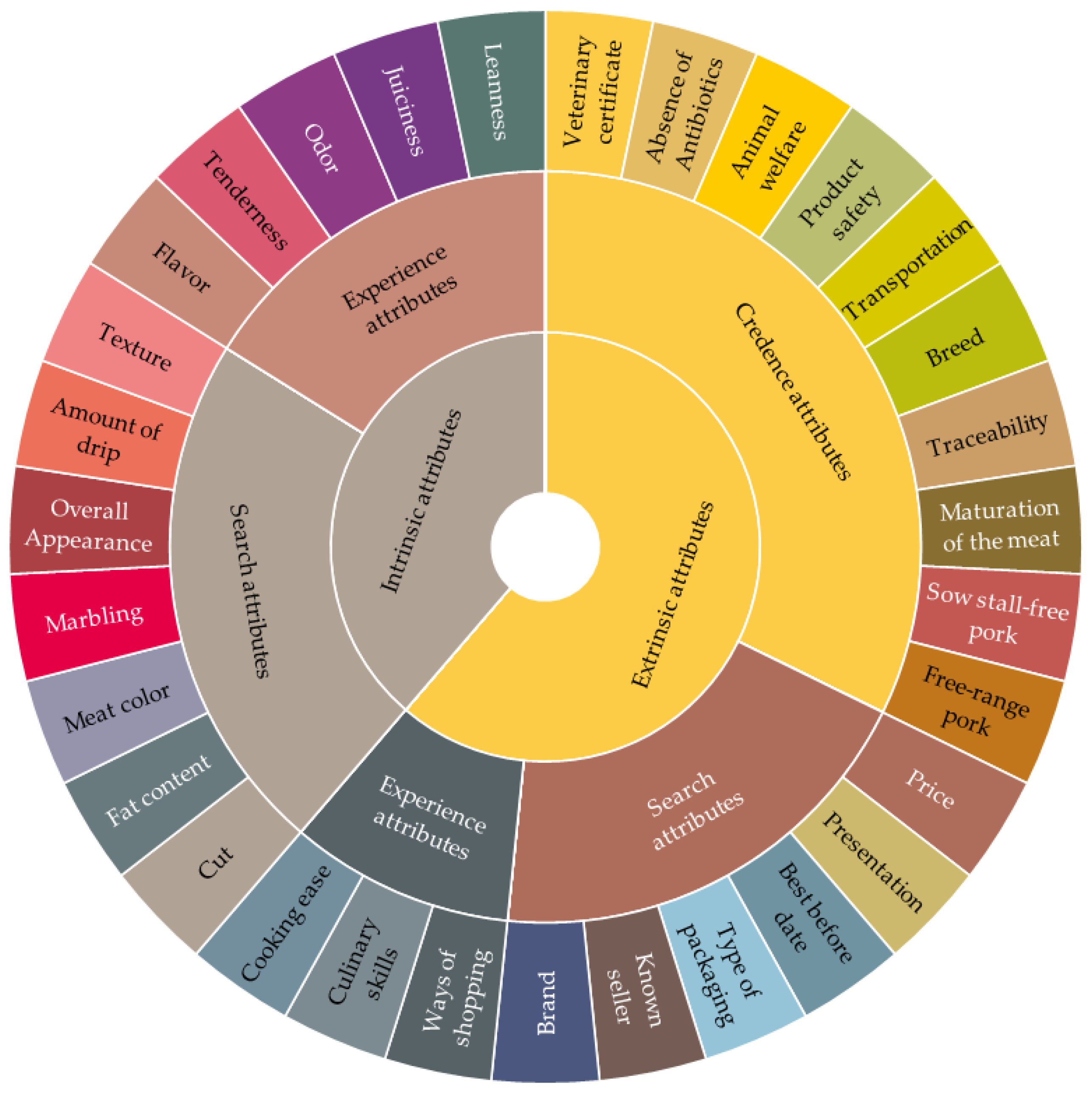
| Initial Database | Google Scholar | ||||
|---|---|---|---|---|---|
| First phase of search | Search field | Abstract, Title, keywords | |||
| Keywords | Intrinsic and extrinsic quality characteristics of beef | ||||
| Search settings | Use all words, Sort by importance and best matching with keywords | ||||
| Period | 2018–2021 | ||||
| Number of publications | n = 9480 | ||||
| Additional keywords | Intrinsic and extrinsic quality characteristics of beef consumer preference | ||||
| Number of publications | n = 4020 | ||||
| Second phase of search | Additional criteria 1 (only full-text articles) | Thesis and chapters excluded | |||
| Additional criteria 2 (subject is fresh beef quality) | Publications excluded (subject is carcass quality, quality of frozen beef, beef products) | ||||
| Additional criteria 3 (subjects are intrinsic and extrinsic characteristics of product) | Publications excluded (subjects are intrinsic and extrinsic factors in meat production) | ||||
| Additional criteria 4 (consumer’s preference) | Publications excluded (production perspective) | ||||
| Third phase of search | Total number of articles retained | n = 41 | |||
| Databases included | Google Scholar, Science Direct, Wiley online library, Emerald Insight, MDPI, Frontiers | ||||
| Google Scholar | Science Direct | Wiley online library | Emerald Insight | MDPI | Frontiers |
| 13 | 14 | 2 | 1 | 10 | 1 |
| Research articles | Review articles | ||||
| 35 | 6 | ||||
| Initial Database | Google Scholar | |||
|---|---|---|---|---|
| First phase of search | Search field | Abstract, Title, keywords | ||
| Keywords | Intrinsic and extrinsic quality characteristics of pork | |||
| Search settings | Use all words, sort by importance and best matching with keywords | |||
| Period | 2018–2021 | |||
| Number of publications | n = 9220 | |||
| Additional keywords | Intrinsic and extrinsic quality characteristics of pork consumer preference | |||
| Number of publications | n = 2690 | |||
| Second phase of search | Additional criteria 1 (only full-text articles) | Thesis and chapters excluded | ||
| Additional criteria 2 (articles are about pork quality) | Publications excluded (subject is carcass quality, quality of frozen pork, pork products) | |||
| Additional criteria 3 (subjects are the intrinsic and extrinsic characteristics of the product) | Publications excluded (subjects are intrinsic and extrinsic factors in meat production) | |||
| Additional criteria 4 (consumer’s preference) | Publications excluded (production perspective) | |||
| Third phase of search | Total number of articles retained | n = 15 | ||
| Databases included | Google Scholar, Science Direct, Wiley online library, Emerald Insight, MDPI, Frontiers | |||
| Google Scholar | Science Direct | Elsevier | MDPI | IOP Conference Series |
| 2 | 4 | 2 | 6 | 1 |
| Research articles | Review articles | |||
| 12 | 3 | |||
| Meat or Meat Product | Characteristics | Purpose | Key Quality and Safety Terms | Reference |
|---|---|---|---|---|
| Minced pork meat | Sensory analysis, color and oxidation measurements | New package | Sensory quality Meat quality | [63] |
| Australian beef loins | pH, color, weight loss during ageing, retail yield, total water content, myofibrillar fragmentation index and lipid (TBARS) and protein (total carbonyl content) oxidation | Different ageing methods | Eating quality of beef loins using the Meat Standards Australia (MSA) sensory protocols | [64] |
| Beef and chicken meats | Microorganisms, amino acid composition profile, chemical composition, mineral concentrations, water mobility and fat content | The effects of repeated freeze–thaw cycles | Meat quality Hygienic quality Stable quality | [65] |
| Beef | pH, color, shear force and cooking loss, water-holding capacity and the glycolytic potential | The occurrence of DFD beef | Meat quality | [66] |
| Beef loins | pH, color, purge, cooking loss, shear force, sarcomere length, particle size and sensory analysis | The prediction of meat and eating quality traits | Sensory quality Meat quality | [67] |
| Pork | Purine measurements and sensory analysis | The effect of purine content | Sensory quality | [68] |
| Pork | pH and redox potential | The effect of different types of electrolyzed water | Microbiological and oxidative quality | [69] |
| Beef | pH, smell, weight loss, water holding capacity, shear force and consumer preference | Different package | Meat quality Microbial quality Consumer test | [70] |
| Nearer to the Target Value Is Better | A Smaller Characteristic’s Value: Better Quality | A Higher Characteristic’s Value Is Better | |
|---|---|---|---|
| Intrinsic attributes | |||
| Credence attributes | |||
| Nutritional values of vitamin B12, Zinc, Iron, so on. | x | ||
| Experience attributes | |||
| Freshness | x | ||
| Taste | x | ||
| Tenderness | x | ||
| Juiciness | x | ||
| Odor | x | ||
| Flavor | x | ||
| Search attributes | |||
| Meat color | x | ||
| Cut | x | ||
| Marbling | x | ||
| Amount of drip | x | ||
| Texture | x | ||
| Hedonic/preference evaluation | x | ||
| Extrinsic attributes | |||
| Price | x | ||
| Hedonic/preference evaluation | x |
| Nearer to the Target Value Is Better | A Smaller Characteristic’s Value: Better Quality | A Higher Characteristic’s Value Is Better | |
|---|---|---|---|
| Intrinsic attributes | |||
| Experience attributes | |||
| Flavor | x | ||
| Tenderness | x | ||
| Taste | x | ||
| Juiciness | x | ||
| Leanness | x | ||
| Search attributes | |||
| Cut | x | ||
| Fat content | x | ||
| Meat color | x | ||
| Marbling | x | ||
| Overall appearance | x | ||
| Amount of drip | x | ||
| Texture | x | ||
| Hedonic/preference evaluation | x | ||
| Extrinsic attributes | |||
| Price | x | ||
| Maturation of the meat | x | ||
| Hedonic/preference evaluation | x |
Publisher’s Note: MDPI stays neutral with regard to jurisdictional claims in published maps and institutional affiliations. |
© 2022 by the authors. Licensee MDPI, Basel, Switzerland. This article is an open access article distributed under the terms and conditions of the Creative Commons Attribution (CC BY) license (https://creativecommons.org/licenses/by/4.0/).
Share and Cite
Rajic, S.; Simunovic, S.; Djordjevic, V.; Raseta, M.; Tomasevic, I.; Djekic, I. Quality Multiverse of Beef and Pork Meat in a Single Score. Foods 2022, 11, 1154. https://doi.org/10.3390/foods11081154
Rajic S, Simunovic S, Djordjevic V, Raseta M, Tomasevic I, Djekic I. Quality Multiverse of Beef and Pork Meat in a Single Score. Foods. 2022; 11(8):1154. https://doi.org/10.3390/foods11081154
Chicago/Turabian StyleRajic, Sara, Stefan Simunovic, Vesna Djordjevic, Mladen Raseta, Igor Tomasevic, and Ilija Djekic. 2022. "Quality Multiverse of Beef and Pork Meat in a Single Score" Foods 11, no. 8: 1154. https://doi.org/10.3390/foods11081154
APA StyleRajic, S., Simunovic, S., Djordjevic, V., Raseta, M., Tomasevic, I., & Djekic, I. (2022). Quality Multiverse of Beef and Pork Meat in a Single Score. Foods, 11(8), 1154. https://doi.org/10.3390/foods11081154








